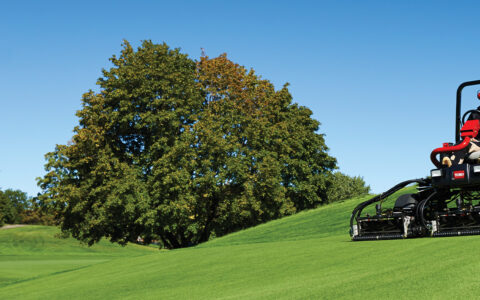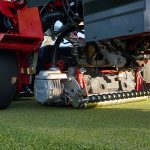When it comes to achieving the perfect aftercut appearance on your course, there’s one thing you can be sure of: there is no magic formula. Many different factors affect aftercut appearance, so it’s impossible to make a recommendation that will work every time, for every course. Turf conditions and turf practices vary from one area to the next, and that’s why Toro offers many different adjustment options and attachments for Reelmaster® fairway mowers to help you achieve the results you want.
When fine-tuning your aftercut appearance, a lot of variables come into play — and there are tradeoffs for each situation. But here are some general rules of thumb that provide a good foundation for achieving optimal quality of cut.
Which reel diameter?
Setting your plan for the best aftercut appearance should start with an assessment: What are your turf practices? Do you have warm- or cool-season grass? In general, 5-inch (127 mm) diameter reels are recommended for cool-season grasses, and 7-inch (178 mm) diameter reels are recommended for warm-season grasses (the larger size and heavier weight help to get down into a thicker canopy for a crisp, clean cut).
If a lighter footprint is desired for your course and you want to use 5-inch (127 mm) diameter reels at a lower height of cut (HOC), below .500 inches (12.7 mm), keep in mind that over time, grass can produce more grain/thatch with a lighter cutting unit — especially during the growing season for warm-season grasses. The result can be less than desirable after cut appearance.
In warm season grasses at HOC lower than .750 inches (19.05 mm), 7-inch (178 mm) diameter reels are better for discharging the larger amounts of grass you encounter, regardless of whether you are front throwing or rear throwing. In addition, this size offers more torque when scalping is required for overseeding, as well as heavier verticutting.
If you chose to cut roughs (typically with HOC over 1 inch (25.4 mm) with reel mowers, 7-inch (178 mm) diameter radial reels are recommended.

Should you use an 8-blade reel or an 11-blade reel?
An 8-blade reel is typically recommended for a height of cut equal to or greater than .500 inches (12.7 mm), and an 11-blade reel is typically recommended for a height of cut between .250 and .750 inches (6.3 mm to 19 mm). For heights of cut that fall where these two recommendations overlap, use the mow speed as a guide. For optimal clip at slower-than-average mow speeds, an 8-blade reel is recommended, whereas an 11-blade reel is recommended for faster-than-average mow speeds.
Using Radial or Forward-Swept Reel?
Again, there are always exceptions to the rule, but the number of obstacles and potential for impact can help determine which type of reel is best. In general, radial reels are better for impact hits because the reel diameter generally does not grow out. That means with a radial reel, if you hit an obstruction, it will simply push the blade back up into its own radius; the reel will still turn and not hit the bedknife. Conversely, when you hit an obstruction with a forward-swept reel, the radius can potentially grow out — hitting the bedknife and stopping.
If your course has a lot of obstructions that could potentially be hit, such as yard markers, sprinkler heads, tree roots and chart paths, a radial reel is recommended. If impact hits are not as much of an issue, forward-swept reels offer a slightly more aggressive cut (lower effective HOC) than radial reels and can producer a cleaner cut in warm-season grasses, especially at lower heights of cuts. Another advantage of forward-swept reels is that they can generally hold their cutting edge slightly longer than radial reels, due to creating a slightly sharper cutting point versus a radial reel.

Other Considerations
Beyond these general rules, Toro’s EdgeSeries™ Dual Point Adjustment (DPA) cutting units offer many different options for adjustments to dial in your cut depending on the type of grass on your course. In addition, Toro offers a wide range of front rollers, rear rollers, brushes, groomers and many more attachments give you the highest quality of cut.
For More Information
For any other questions or recommendations about maintaining and adjusting your mowers, please contact your local Toro distributor.





